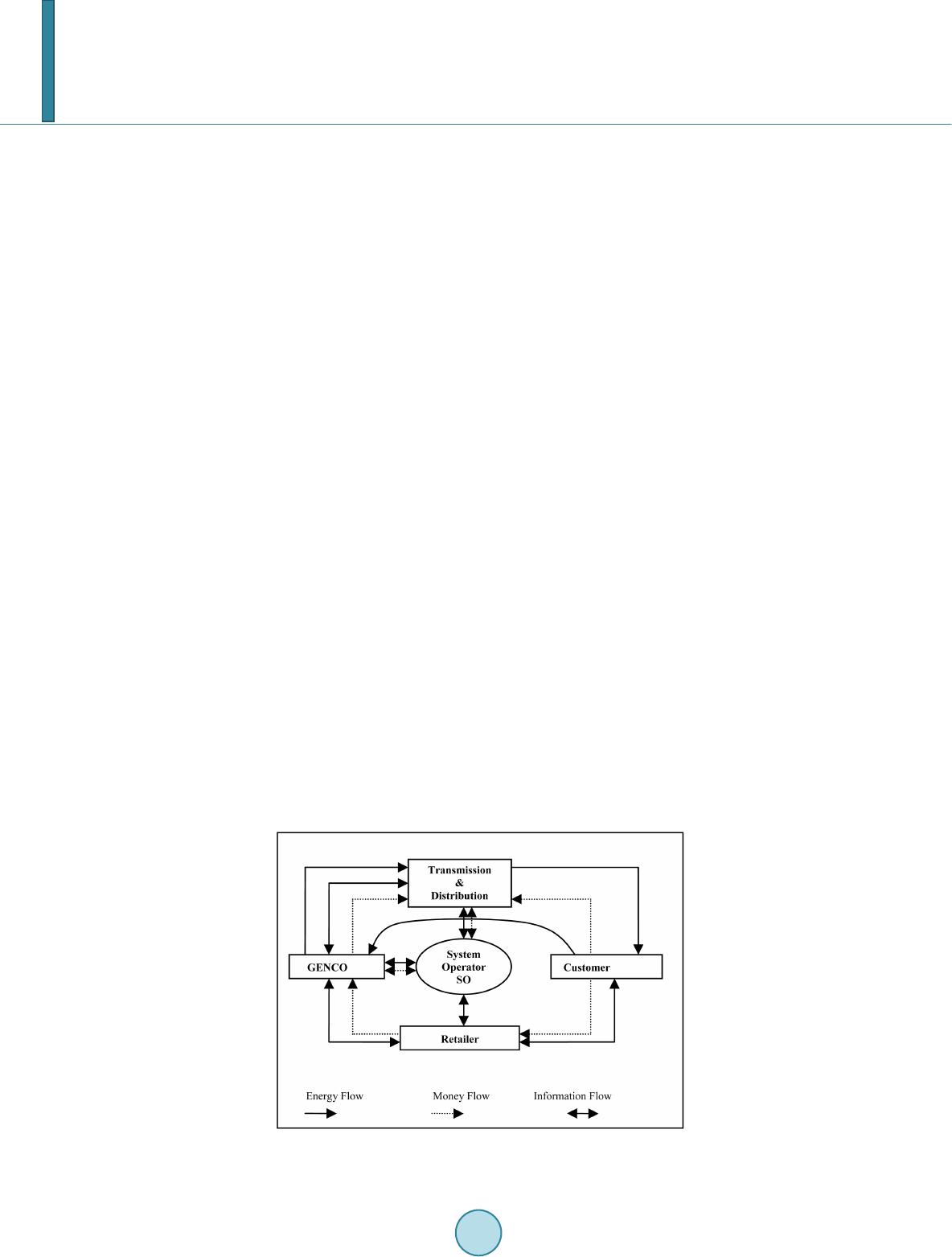 Journal of Power and Energy Engineering, 2014, 2, 395-402 Published Online April 2014 in SciRes. http://www.scirp.org/journal/jpee http://dx.doi.org/10.4236/jpee.2014.24053 How to cite this paper: Makwana, U.L., et al. (2014) Assessment of Available Transfer Capability for Congestion Manage- ment in Restructured Electrical Power Network for Competent Operation. Journal of Power and Energy Engineering, 2, 395-402. http://dx.doi.org/10.4236/jpee.2014.24053 Assessment of Available Transfer Capability for Congestion Management in Restructured Electrical Power Network for Competent Operation U. L. Makwana1, S. K. Joshi2, Mehul D. Solanki3 1Electrical Engineering Department, L.D. College of Engineering, Ahmedabad, Gujarat, India 2Electrical Engineering Department, The Maharaja Sayajirao University of Baroda, Vadodara, Gujarat, India 3Electrical Engineering Department, S.S. Engineering College, Bhavnagar, Gujarat, India Email: ulmakwana@gmail.com, skjoshi_59@yahoo.co.in, solankimehuld@gmail.com Received January 2014 Abstract Congestion is the prime cause of problems, due to open access of power system. The AC Power Transmission Congestion Distribution factor (PTCDF) is suitable for computing change in any line quantity for a change in MW bilateral transaction. The proposed PTCDF method is more accurate as compared to the DC power distribution factor. With PTCDF ATC can be calculated. After calcu- lating ATC it is possible to know the valid multiple transaction on power system. With the help of ATC calculations congestion problem can be solved in restructured electrical power network. The paper presents the method for calculating ATC using PTCDF. Keywords ATC (Available Transfer C ap abil i ty ); Deregulated Market; OASIS; ISO; Open Access; Generating Companies (GENCOS); Transmission Companies (TRANSCOS); Distribution Companies (DISCOS); PTCDF (Real Transmission Congestion Distribution Factor); QTCDF (Reactive Transmission Congestion Distribution Factor) 1. Introduction Many electrical power utilities, worldwide, have been obligatory to change their way of operation and business, from vertical integrated to unbundled open market structured [1]. The main aim of the restructured is to bring some form of deregulation or re-regulation in certain part of Electricity business sector in order to allow compe- tition in wholesale and retail level. In addition, it is expected to provide choice and social advantage to custom- ers. This can be specially observed in countries like UK, Sweden, Finland, Norway, US and some countries of South America [2]. The reasons for change have been many and have different over regions and countries. For developing countries, the main issues have been a high demand growth joined with insufficient system man- agement and irrational tariff policies. This has affected the availability of financial resources to upkeep invest-  U. L. Makwana et al. ments in improving generation and transmission capacities. In such circumstances, many utilities were enforced to reorganize their power sectors under pressure from international funding supports. The goal of changing the way of operation, i.e. re-regulation, or deregulation, as we say, is to augment com- petition and bring consumers new choices and economic benefits. In developed countries, on the other hand, the driving force has provided electricity at lower prices and offer them a greater choice in purchasing economic energy. The role of an Independent System Operator (ISO) [3] in a competitive market environment would be to faci- litate the complete dispatch of the power that gets contracted among the market players. With the trend of an in- creasing number of bilateral contracts being signed for electricity market trades, the possibility of insufficient resources leading to network congestion [4] may be unavoidable. Whenever the physical or operational con- straints in a power system become active, the system is said to be in a state of congestion [2] [4] [5]. In this scenario, congestion management (with ATC) becomes an important issue [6 ]-[8]. Real-time transmis- sion congestion can be defined as the operating condition in which there is not enough transmission capability to implement all the traded transactions all together due to some unexpected contingencies. This highlights the fact that, in a restructured scenario, contracts between trading entities must be considered as system decision va- riables (in addition to the usual generation, loads and flows). Congestion can be identified by calculating ATC [ 4] of all line with considering all transactions. ATC, between a given interfaces in the transmission system, is a measure of its utilized capacity for further commercial activity over and above surviving transfer obligations. The ATC can be determined with the static constraint such as line flows, voltage limits and maximum loadibility limit. ATC calculation must be accurate and fast because it is posted on OASIS website by ISO [3]. For deter- mination of ATC, network sensitivity based methods utilizing A.C. Distribution factors are being widely used [9]. 2. Electricity Market Entities and Model Many electric utilities, worldwide, have been mandatory to operate in different ways from vertically integrated functioning to open market systems. In developing countries, the main concern has been high demand growth associated with insufficient system management, lack of funds for capital investment in generation and trans- mission systems. Market Participants a) Generating Companies (GENCOs): GENCOs generate electricity and have the opportunity to trade the electricity to entities with which they have talked sales contracts. GENCOs are more often a group of generating units within a single company ownership structure with the lone objective of producing power. GENCOs may sell reactive power and operating reserves. b) Transmission Companies (TRANSCOs): A transmission company (TRANSCO) transport electricity using a high voltage, bulk transmission system from GENCOs to Distribution Companies (DISCOs)/Retailers for de- livering power to the customers. A TRANSCO has role of building, owning, maintaining, and operating the transmission system in a certain geographical region to provide services for maintaining the overall reliability of the electrical system and provides open access of transmission wires to all market entities in their system. The investment and operating costs of transmission facilities are recovered using access charges, which are usually paid by user within the area, and transmission usage charges based online flows contributed by each user. c) Distribution Companies (DISCOs): A distribution company (DISCO) distributes the electricity, through its facilities, to customers in a certain geographical region. They buy wholesale electricity either through the spot markets or through direct contracts with GENCOs and supply electricity to the end-user customers. A DISCO is a regulated utility that constructs and maintains distribution wires connecting the transmission grid to the end use customers. A DISCO is responsible for building its electric system to maintain a desired degree of reliability and availability. d) Customers: A customer is the end-user of electricity with certain facilities connected to the distribution system in the case of small customers, and connected to transmission system in the case of bulk customers. In a restructured system, customers are no longer obligated to purchase electricity from their local utility company and several option s to buy electricity. It may choose to buy electricity from spot market by bidding for purchase or through direct contracts with GENCOs or even from the local distribution company with the best overall val- ue.  U. L. Makwana et al. e) Market Operator: A market operator is an entity responsible for operation of electricity market trading. It receives bids from the market participants and determines the market price based on certain criteria in accor- dance with the market structure. The markets may have different trading schemes such as hourly trading for the next day or trading in future weeks, months, or years ahead. f) System Operator: A competitive market would require an independent operation and control of the grid, which is assured establishing an Independent System Operator (ISO). The ISO is an entity, which is delegated with the responsibility of ensuring the security, reliability, and efficient operation of an open access transmission system [3]. It controls transmission tariff, maintains the system security, coordinate maintenance scheduling, and has a role in coordinating long term planning. It is an independent authority and does not join in the electricity market trades. The ISO has the authority to commit and re-dispatch the system resources and to curtail loads for maintaining the system security i.e. to remove the transmission violation, balance supply and demand, and maintain the acceptable system frequency. This responsibility of ISO is to form the basis for the functionality of the Transmission Dispatch and Congestion Management System (TDCMS). So can procure various ancillary services such as supply of reactive power or emergency reserves from other entities in the system to preserve re- liability. In general, there are two possible structure of SO (System Operator) and the choice of the structure de- pends on the ISOs objective and authority. These structures are: 1) Min SO 2) Max SO Min SO is mainly concerned with maintaining transmission security in the operation of the power market to the extent that SO is able to schedule power transfers in a constrained transmission system. This structure is based on harmonized multilateral trades and has no role in the market administration. California Independent System Operator (ISO) is an example of this structure. Max SO includes a power exchange which is an independent non-government and non-profit entity that en- sures a competitive market place for electricity trades. It performs the function like deciding and posting of Market Clearing Price (MCP). g) Aggregators: An aggregator is an entity or a firm that combines customer into a buying group. The group buys large blocks of power and other services at cheaper prices. The aggregator may act as an agent between customers and retailers. h) Brokers: A broker of electric energy services is an entity that acts like a middleman in a market place in which these services are priced, purchased and traded. A broker does not take a label on available transaction, generate, purchase or sell electric energy, but assist transactions between buyer and seller. A broker may act as an agent between GENCOs and DISCOs. i) Retail companies (RETAILCOs): A RETAILCO obtains legal approval to sell retail electricity. A retailer purchases electric energy and other necessary services in various packages for trade. A retailer may deal indi- rectly with end-use customers through aggregators. 3. Brief Concepts of Regulation and Deregulation Regulation means that the Government has set down laws and rules that put limits on and define how a particu- lar industry or company can operate. Nearly all industries in all nations are regulated to some extent. Very com- petitive businesses such as auto manufacturing, airlines and banking are all heavily regulated with myriad gov- ernment requirements defining what they must, can, and cannot do, and what and to whom and when they must report their activities. Regulation of electric utilities is not the only way government can control the electric power industry within its jurisdiction. The other way is to own and operate the power company directly, as a government utility. Deregulation in power industry is a restructuring of the rules and economic incentives that government set up to control and drives the electric power industry. As the terms suggest, they represent fundamentally opposite ideas. But neither concept is necessarily good or bad. Both regulation and deregulation make sense, and one or other is preferable under certain conditions. 3.1. Structure of Regulated Industry The electric power industry has over the years been controlled by large utilities that had an overall authority over all activities in generation, transmission and distribution of power within its domain of operation. Such util-  U. L. Makwana et al. ities have often been referred to as vertically integrated utilities. Such utilities obliged as the only electricity provider in the region and were pleased to provide electricity to everyone in the region. The money flow is un- idirectional, i.e. from the consumer to the electric company. Similarly, the information flow exists only between the generators and the transmission systems. The utilities being vertically integrated, it was often difficult to se- gregate the costs involved in generation, transmission or distribution. So, the utilities often charged their cus- tomers an average tariff rate depending on their aggregated cost during a period. 3.2. Structure of De-Regulated Industry The configuration shown in the F igure 1 is not a common one. There exist variations across countries and sys- tems. A system operator is appointed for the whole system and it is entrusted with the responsibility of keeping the system in balance, i.e. to ensure that the production and imports continuously match consumption and exports. Naturally, it was required to be an independent authority without involvement in the market competition nor could it own generation facilities for business. This system operator is known as Independent System Operator (ISO). Different power sellers will deliver their product to their customers (via retailers), over a common set of T and D wires, operated by the independent system operator (ISO). The generators, Transmission and Distribu- tion utility and retailers communicate ISO. Mostly, customer communicates with the retailer, demanding energy. The retailer contacts the generating company and purchases the power from it and makes it transferred to its customers place via regulated T & D lines. The ISO is the one responsible for keeping path of various transac- tions taking place between various entities. 4. Congestion Management Whenever the physical or operational constraints in a power system become active, the system is said to be in a state of congestion. 4.1. Congestion Management Congestion management [2] is one of the most challenging aspects in a multi-buyer/multi-seller system. In the vertically integrated utility structure, all entities such as generation, transmission and distribution are within the domain of a central energy management system. Generation is dispatched in order to achieve the system least cost operation. In such systems, congestion management is usually taken care of by determining the optimal dispatch solution using a model similar to the optimal power flow or the security constrained economic dispatch problem. This effectively means that a generation pattern is determined such that the power flow limits on the transmission lines are not exceeded. Figure 1. Structure of De-regulated industry.  U. L. Makwana et al. 4.2. Methods for Congestion Management Price Area Congestion Management Optimal Power Flow (OPF) based Congestion Management Available Transfer Capability (ATC) based Congestion Management 4.3. Available Transfer Capability (ATC) It is a measure of the transfer capability remaining in the physical transmission network for further commercial activity over and above already dedicated uses. Mathematically ATC is defined as the Total Transfer Capability (TTC) less the Transmission Reliability Margin (TRM), less the sum of existing transmission commitments (which includes retail customer service) and the Capacity Benefit Margin (CBM) [4 ]. ATC = TTC − TRM − Existing Transmission Commitments (Including CBM). 5. Mathematical Formulation of ATC Congestion do occur in both vertically bundled and unbundled systems but the management in the bundled sys- tem is relatively simple as generation, transmission and, in some cases, distribution systems are managed by one utility. The management of congestion is somewhat more intricate in competitive power markets and leads to some quarrels. To manage the congestion in real time operation, normally following methods are adopted: 1) Use of existing resources for congestion management such as rescheduling of generation based on mini- mum bids, operation of on load tap changers, phase and regulators, and various FACTS controller etc. 2) Give the timely data regarding the possibility of having a particularly line congested and economic incen- tives to system users to adjust their requests and remain within the system constraints. 3) Curtailment of the transactions as a last option. When it is impossible to wait for the system users to respond to economic measures, the second option is de- veloped for giving sufficient information regarding the congestion probability to the system users so that they can adjust their requests for system services and avoid congestion. Various congestion management schemes for different restructuring paradigms have been stated in different literatures. Various optimization-based methods for load curtailment and rescheduling of generation have been described for congestion management. The congestion cost calculation and allocation of the congestion based approaches for congestion management [9]. During the real time dispatch, the knowledge of the group of system users, which have similar effect on the transmission constraints, is of interest. Congestion management using Available Transfer capability (ATC) has been reported in this dissertation [4]. By calculating ATC for all lines of given a network and posted this value on website known as OASIS (Open Access Same Time Information). The customer who wants to do transaction can observe the value of ATC from the web site for a given hour. So the customer can see whether the transaction is possible or not. If the transac- tion is greater than the value of ATC the transaction is not allowed or limited to ATC. Methods for ATC Calculation Network Sensitivity Factor based Approach: Real time congestion management requires very fast relief of con- gestion otherwise it threatens system security and stability both. So it very important for Independent system operator (ISO) [3] to identify the most sensitive zones as quickly as possible. This network sensitivity method helps system operator (ISO) to provide accurate and fast information about the contribution of each generators and load to congestion line. The two different methods to find network sensitivity factor is as shown below: 1) DC Load Flow Based Approach (DC Method) 2) AC Load Flow Based Approach (AC Method) The transfer margin computation can be implemented with a range of power system models and computation techniques. Here, following three ATC calculation methods are presented. 1) ATC calculation using Power Transfer Distribution Factor (PTCDF) 2) ATC calculation using Optimal Power Flow (OPF) 3) ATC calculation using Continuation method  U. L. Makwana et al. PTCDF and LODF (Line Outage Distribution Factor) method is extensively used in ATC calculation. Here, this method is explained thoroughly. Other two methods are not considered as they are rarely used for calcula- tion of ATC [6]-[8] [10]. The most sensitive zones have been identified as the union of real and reactive line flow sensitivity indices [11]. The TCDFs have been derived utilizing the sensitivity properties of the New- ton-Raphson load flow (NRLF) Jacobian as given below. (1) (2) (3) ''k nij inijjn QTCDFc ndn= + (4) where ( ) sin ijijiijijijji aPVV Y δ θδδ =∂∂=+ − ( ) sin ijijjijijijji bPVV Y δ θδδ =∂ ∂=−+− ( ) cos2 cos ijijij ijijjii ijij cPV VYVY θδδ θ =∂∂=+ −− ( ) cos ijijji ijijji dP VVY θδδ =∂ ∂=+− ( ) ' cos ijijiijijijji aQVV Y δ θδδ =∂∂=+ − ( ) ' cos ijijjij ijijji bQVV Y δ θδδ =∂ ∂=−+− () ' sin2 sin ijijijijijjii ijijish cQ VVYVYVY θδδ θ =∂∂=−+ −−− ( ) 'sin ijijji ijijji dQ VVY θδδ =∂∂=−+− where are Jacobean elements with decouple principle. The new line flows is given by following equations (5) ( ) maxmax 0 ij ij nij ijn PPPPTCDF∆= − (6) ( ) max max min ij ij nn ATC P∴=∆ (7) If proposed transaction ΔPkn is less then ATCn then transaction is allowed, if not then transaction must be re- jected or limited to ATC. Thus ATC can be used as a rough indicator of relative system security [4]. ATC in- formation can help ISO to determine the validity of bidding results in an open access deregulated [1] Electric market when timely ATC information is very important. It can also help the power market participants to place bid strategically when congestion happens. So when the ISO [3] posts the ATC value for particular transaction. 1) It means that the entire network is capable of carrying the posted ATC MW for a particular transaction; 2) It does not mean that the ATC is capacity of the interface connecting node i - j. 6. Algorithm for Pr ogram A. Input data file & run base-case load flow. B. Read line flows. C. Input number of transaction, source bus & destination bus. D. Find out jacobian j11, j22, take inverse of j11, j22 as M, N.  U. L. Makwana et al. E. Find PTCDF & QTCDF F. Find out Maximum Allowable transaction for all possible Transaction & for all line max 0 ijmax ij ijij nn PP PPTCDF − ∆= G. Find ATC (Available transfer capacity) minimum of all possible maximum Allowable transaction. H. Calculate PTCDF with transaction (n). I. Find out Maximum Allowable transaction for all possible transaction. J. Check for convergence (Is transaction is over?) K. If “no ” go to step (5) L. If “yes” calculate final ATC & Print results. 7. Results The system comprises of six buses [4]. Out of which four buses are with generator and other are load buses this is one of the smallest systems used for power system studies. We have tested the analysis software for this sys- tem with basic parameters as per the standards. Input data files: 1. Basic line data file: nrlined ata.txt From To R X Bc Max. Capacity 1 2 0.04 0.08 0.2 100 1 5 0.04 0.08 0.2 100 2 4 0.04 0.08 0.2 100 3 5 0.04 0.08 0.2 100 3 6 0.04 0.08 0.2 100 4 5 0.04 0.08 0.2 50 4 6 0.04 0.08 0.2 100 2. Basic bus data file: nrb us data. txt Bus no Bus Type V Angle Pd Qd Pg Qg Qin Qmax Qin 1 1 1.1 0 70 10 18 0 0 0 0 2 2 0.9 0 45 10 100 0 0 0 0 3 2 1 0 50 10 86 0 0 0 0 4 2 1 0 30 10 130 0 0 0 0 5 0 1 0 35 10 0 0 0 0 0 6 0 1 0 100 10 0 0 0 0 0 3. Bus voltage file: busvoltage.txt Bus no Volt 1 11 2 11 3 11 4 11 5 11 6 11 Note: 1 = Slack bus; 2 = Generator bus (PV); 0 = Load bus (PQ).  U. L. Makwana et al. 4. Out-put results: Li n es ATC (Mw) 1 - 2 119.155 1 - 5 216.650 2 - 4 174.182 3 - 5 745.279 3 - 6 1019.906 4 - 5 31.133 4 - 6 230.301 From the above table, it can be depicted that the ATC of the given 6 bus system is calculated as 31.133 MW. ATC is nothing but the measure of the capacity of entire network to carry out this much Power to be transacted 8. Conclusion It concludes that the development of the AC Power Transmission Congestion Distribution factor (PTCDF) suit- able for computing change in any line quantity for a change in MW bilateral transaction. The proposed PTCDF is more accurate as compared to the DC power distribution factor. With PTCDF ATC can be calculated. For multiple transactions ATC calculation is very important and mandatory too. ATC calculations can be used to solve congestion problem in restructured electrical power network. References [1] Abhayankar, A.R. and Khaparde, S.A. Introduction to Deregulation in Power Industry. https://www.yumpu.com/en/document/view/20681876/introduction-to-deregulati on-in-power-industry-nptel [2] Khaparde, S.A. Congestion Management. h ttp ://nptel.iitm.ac.in/courses/108101005/5 [3] Dr Sanjay Gupta Senior Consultant Energy and Utilities Group Infosys Technologies Limited Bangalore, India. Fo r- mation of Independent System Operator (ISO). India. [4] Kushalani, S., Khaparde, S.A. and Soman, S.A. (2001) Congestion Management in the Emerging Energy Market Structure. Cigre Regional Meeting on Bulk Power Transmission System Integration in Developing Countries, New Delhi, 16-24. [5] Christie, R.D. , Wollenber g, B.F. and Wangensteen, I. (2000) Transmission Management in Deregulated Environment. IEEE Proceedings, 88, 170-195. http://dx.doi.org/10.1109/5.823997 [6] Ejeb e, G. C ., Tong, J., Wai gh t, J . G. , Frame, J.G. , Wang, X. and Tinney, W.F. (1998) Available Transfer Capability Calculations. IEEE Transactions on Power System, 13, 1521-1527. http://dx.doi.org/10.1109/59.736300 [7] Gravener, M.H., Nwankpa, C. and Yeoh, T.-S. (1999) ATC Computational Issues. 32nd Hawaii International Confe- rence on system Sciences. [8] Sh aaban , M., Ni, Y.X. and Wu, F.F. (2000) Transfer Capability Computation in Deregulated Power Systems. 33nd Hawaii International Conference on System Sciences. [9] K uma r , A. and Sr ivastav, S.C. (2001) Power Transaction Allocation in a Deregulated Market using AC Power Transfer Distribution Factors. Cigre Regional Meeting on Bulk Power Transmission System Integration in Developing Coun- tries, New Delhi, 9-17. [10] Hamoud, G. (2000) Assessment of Available Transfer Capability of Transmission System. IEEE Transaction on Power System, 15, 27 -32 . [11] Chakravart i, A. and Haldar, S. Power system Analysis. 3rd Edition, PHI India Publications.
|